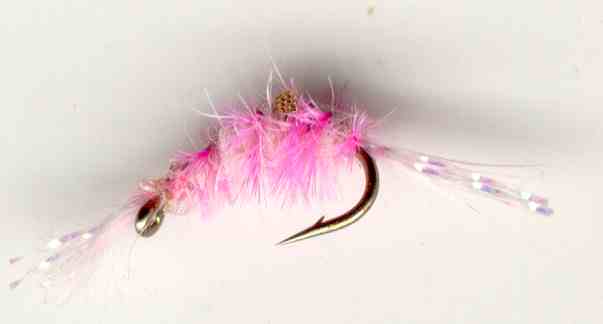The Pink Scud Fishing Fly
ink Scud fly-fishing freshwater shrimp fly pattern. Scuds come in a wide range of colors. A good rule of thumb is, darker the water the darker the coloration of the scuds.

SCUD FLY PATTERNS. (also a great freshwater shrimp or louse imitation) Hook size 14 16 18 - $US each
FRESHWATER SHRIMP
These delicacies are available as a food source to trout throughout the year. They are part of the Amphipoda order of the family genus Gammarus. Here in Britain we have three species the most common being Gammarus pulex. Gammarus lacustris is found in Scotland's Lochs and Gammarus duebeni can be found in Irish waters. Gammarus pulex reaches about 20mm nearly the same size as a freshwater louse. They can be identified by the fact that shrimps, when held in the hand, has a slightly curved and flattened body and will always lay on its side where as the louse will try to remain upright and freely walk upon the palm of your hand. The color of the shrimp will vary light and dark shades of pink, gray and brown.
Freshwater shrimps are found in many ponds, reservoirs, lakes and most streams and rivers. They are normally found in shallower areas rather than in the deep open water stretches. The like well oxygenated alkaline water but can tolerate some acidity. They are an excellent indicator on how clean the water is as they cannot survive in polluted water. the hide under stones, sunken logs and other river and lake bed debris. They also lurk near the base of aquatic plants. They feed on dead plant material, smaller living marine organisms and other decaying organic material.
A shrimps body consists of three sections: the pleon, peraeon and the head. The head carries the eyes, mouth and distinctive forward facing antennae. The second section contains the main legs and gills. The first two legs are used for grasping food and transporting it towards the mouth. the others are used for walking. The last section contains more legs. The front section help in swimming and to pass water over the gills. The very distinctive rear section legs are used to jump and give the shrimp its characteristic springing movement when threatened or disturbed. The front antennae and rear jumping legs are important features that should be included in any fly imitation. Mating occurs during the spring and summer. The lay about 20 eggs in a batch and kept in a brood pouch on the female. they hatch 16 to 17 days later but remain in the pouch for a few more days. The young develop and grow by a series of moults. The first takes place normally one week after hatching. If the amount of food available locally is high then development occurs at a faster rate. After about the 10th moult they are sexually mature and the sequence starts again.
You may find some shrimp with orange blobs in the egg sack. this is often confused a shrimp egg. In fact it is a nasty fish parasite called Pomphorhynchus laevis. Fish are attracted to this colour and it can be beneficial to incorporate a blob of orange on an imitation fly. The parasite releases its eggs whilst still inside the host fish. These pass out as fish shit, whoops sorry fish feces, and sink to the river or lake bed. The shrimp eat them and the eggs hatch within the intestine of the shrimp, yuk! They then bore through the gut and stay within the body cavity of the shrimp until they develop into an orange colored cystacanth; the orange blob. They are in turn eaten by a fish. the parasite attaches itself the the stomach wall. of the host fish and the process starts again.
CUSTOMER'S COMMENT
Three of us are heading back to Fort Smith, Montana USA and to fish a 13 mile stretch of the Big Horn River. The Pink Scuds work well there. We catch browns in the 20+ inch range and some smaller rainbows. Also a few whitefish that put up a great fight.
Dick, South Dakota


Fly Fishing books

